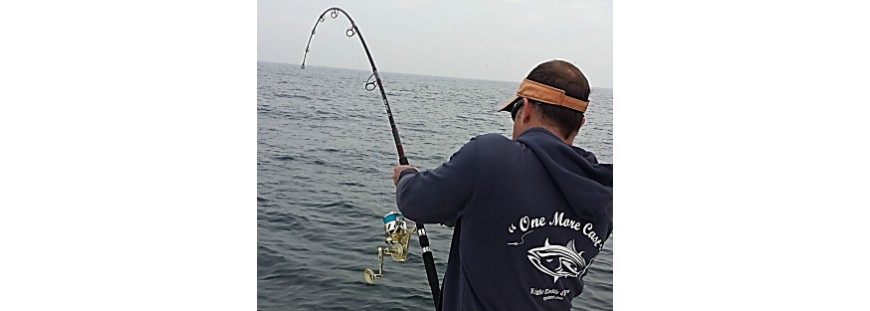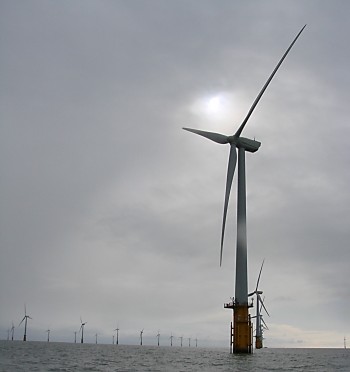“Ocean Planning” Offers Anglers An Opportunity We Should Take
If you’ve spent any real time offshore, you know that some spots are more “fishy” than others. To any fishermen worth his/her salt, that’s just a given.
Often, a spot’s productivity is due to hard-bottom, structure or rapid depth changes. But other times, for no particular reason we are aware of, some areas seem to hold “life” more consistently than others. By life I mean anything and everything: turtles, whales, dolphin, sandeels, squids, etc… All the stuff we look for when trying to determine whether or not tuna, mahi, billfish, stripers, bluefish or any other fish that we might want to target could be around.
Those particular “go-to” areas are simply more important. As anglers we know that, perhaps more than anybody. So why am I waxing about something you guys already know? Well, it’s because we’re facing a new age as fishermen. The ocean is no longer “ours.”
As the coastal population continues to boom, and the ever-increasing demand for energy continues, we’ll likely see, within our lifetimes, ocean development at a scale that’s almost hard to imagine.
Yes, we can all just be anti-development/anti-everything as some fishermen and some ENGOs certainly seem to be. But to think such development isn’t gonna happen just because they are opposed is incredibly naïve, and, well, stupid.
While it certainly hasn’t been broadcast widely, large swaths of ocean bottom off the Mid-Atlantic and New England coasts have already been carved out for potential wind energy development. If you’ve ever been to the UK and looked out onto the English Channel, you get a good idea of scale. And let me tell you, these things can cover A LOT of ground.
Let me be clear that I am not under any circumstances bashing offshore wind-power. I think we need to move forward with sustainable wind energy. In fact, in my view, particularly where I am (the NY Bight), this could be quite beneficial for the angling community. Yes there will absolutely be some disruption during the construction cycle, but can you imagine the offshore structure? I mean holy (expletive)… The tog, black sea bass, the mahi, the tuna that come in there to chase bait!!! It could be epic! Assuming we’d have access of course. Thus far I’ve heard nothing to make me believe me that we won’t. And believe me I’ve asked about this at every junction.
But where they put these things is pretty damn important. We certainly don’t want them on hard bottom, or just those “fishy” areas that always seem to produce. On that note, we sure as hell don’t want a natural gas terminal at Ambrose or on Cholera Bank right? And oil development? Man, I don’t want to get into that here.
The overarching point though is that ocean use is rapidly increasing, and it needs to be addressed on a high level, first of all to minimize the ocean use conflicts that will inevitably arise, but perhaps more importantly, to avoid adverse ecosystem impacts (read: “effects to our fish-catching opportunities”).
To address all this, there has been what I consider to be a relatively new “ocean planning” movement. Yes, the states have been engaged for an awful long time, but the feds just institutionalized an ocean planning initiative in 2010 with a National Ocean Policy Executive Order, which calls for the creation of Regional Planning Bodies (RPBs) to coordinate and implement regional ocean planning with state, Federal, tribal, and Fishery Management Council representatives.
Now, the usual “they’re-out-to-get-us” crowd would have you believe that all this ocean planning stuff is a back-door way to close down large swaths of ocean to fishing, but that just isn’t true. Charlie Witek already covered this pretty well in a recent blog, so I’m not gonna get into the conspiracy theory thing. The brass tacks here is that a big part of what ocean planning seeks to do is ensure that industry (wind, gas, oil, commercial fishing, etc.) doesn’t screw up marine habitat, or shut us out of historically productive fishing grounds.
So a major focus of ocean planning right now is the development of a stronger base of information to make well-informed decisions on what’s appropriate where.
With that said, the Mid-Atlantic Regional Council on the Ocean (MARCO) hired Duke University’s Dr. Pat Halpin – one of the world’s foremost scientists in the field of marine geospatial ecology – to work with leading ocean researchers to identify the Mid-Atlantic’s most important “ecological” areas. Last week, Halpin’s team released an initial set of Mid-Atlantic places that are unique because of their massive amounts of marine life. He has developed a first map of “abundance core areas” – places where more than 50 percent of the region’s fish, birds, corals, and marine mammals can be found over the course of the year. These places make up part of what the Regional Planning Body is calling “ecologically rich areas” (ERAs).
What we’re talking about here are places of high productivity; areas that are probably critical to the ocean’s functioning and resiliency; places where spawning, breeding, feeding and migration happen. The places we tend to find fish!
Let me be very clear again. Identifying an area as an ERA doesn’t mean such an area would be a marine reserve or that fishing activities can’t occur there. It just means we need to be careful about what we allow. Like, well, we don’t want to put a wind farm on top of a coral community. Yes, the science on these things is probably not perfect – and, in fact, more data on fisheries will be needed as we continue to improve our maps into the future – but this is a huge first step, and we need to take advantage of this opportunity. Ocean use is increasing, and decisions are made every day about where and how to develop. We certainly can’t wait and let “the perfect be the enemy of the good.” We need to act on what we have and know now to make sure some of these places continue to exist.
The Regional Fishery Management Council system is, of course, limited in its ability to address threats to ocean habitat, other than those caused by fishing. Yet, the Fishery Management Councils can indeed help protect these and future ERAs by using existing processes to examine what impacts things like bottom trawling may have on ERAs, and to take steps as needed to address existing or potential problems. The Councils should continue to identify essential fish habitat (EFH), create habitat areas of particular concern, and urge federal agencies to do their part to protect these and other types of sensitive habitat. The ERAs and their component map layers will be valuable new resources to help inform such efforts.
Perhaps more importantly, as offshore fishermen, we need to make it very clear to the Regional Planning Bodies (RPBs) that we want the participating federal and state agencies to act within their existing authorities to protect ERAs. This is pretty darn important if we want those go-to spots to continue to produce.
You can do so by signing onto the below letter. Shoot me a quick email with your name and address and I’ll make sure we get you on.
Do it now!
Dear Mr. LaBelle, Ms. Schultz, and Ms. Leonard:
We, members of the recreational fishing public, believe that some offshore places, whether due to their habitat, structure or the marine life that uses the area, are simply more valuable than others in terms of how the ocean functions. These places need to be given heightened consideration before siting and other development decisions are made in order to ensure the long-term health of the region’s fish and shellfish. Because of this, we wish to convey our support for the Mid-Atlantic Regional Council on the Ocean’s (MARCO) work to identify ecologically rich areas (ERAs) and to encourage the federal and state agencies serving on the Mid-Atlantic Regional Planning Body (RPB) to act within their existing authorities to conserve these places, which are so critical to the future of our fisheries. We are seeing growing threats to fisheries in a developing ocean, especially with increased demands for offshore energy development and the disruption of habitat by sand extraction. Good ocean planning can identify key ecological areas; areas that need protection through planning, regulatory and management decisions by federal and state agencies.
Recently, the Mid-Atlantic Fishery Management Council (Council) acknowledged the importance of habitat protection through unanimous passage of policies on non-fishing activities that impact fish habitat. The preamble calls on agencies to help protect sensitive habitat, noting that “[a]ctions and policies that protect and restore fish habitat and marine and estuarine ecosystem function, are clearly an investment in the health of our coastal communities, and the fisheries on which they depend.” The Council recognizes that beyond developing fishery regulations and making recommendations to agencies that regulate offshore uses, it is limited in its ability to address threats to ocean habitat.
Therefore, it is critical that federal and state agencies that do have the authority to regulate non-fishing activities pledge to use their existing authorities to conserve our ecologically important places, such as those identified through the MARCO process. We urge agencies like the Bureau of Ocean Energy Management to ensure that actions that they oversee like offshore wind power facility siting and development and sand and gravel mining take into account the value of the identified ERAs and conserve the ecological functions that make these areas important.
We see an increasing amount of ocean use, with decisions made every day about where and how to develop our oceans. Therefore, action to conserve ERAs must be taken now, with all parties committed to continued data collection and ERA refinement. Thank you in advance for your commitment to safeguard these important places for our future use and enjoyment.
Sincerely,
Jeff Deem
Recreational Fishing Representative, Mid-Atlantic Regional Council on the Ocean’s Stakeholder Liaison Committee
John McMurray
Captain, Charter Boat Operator, New York
Recreational Fishing Representative, Mid-Atlantic Regional Council on the Ocean’s Stakeholder Liaison Committee





Very well said!
Important issue that needs to be watched
John, another great topic! You stated the sportsman’s position very well and backed your opinion in reality not politics!
Pingback: MARCO Needs Recreational Angler Input - delaware-surf-fishing.com
Pingback: “Ocean Planning” Offers Anglers An Opportunity We Should Take « Wild Oceans
Because of a Federal government restriction (I don’t recall the exact clause), the MidA RPB cannot work directly with independent representatives. MARCO has become the link for John and I to be the recreational fishing representatives for both MARCO and the MidA RPB.
The formal name for this group of representatives, which includes other interest groups and industry representatives, is the ‘Stakeholder Liaison Committee (SLC). Please feel free to contact either of us with any suggestions, questions or concerns.
I can be reached at jeff.deem2@gmail.com
John has a link above which connects him at john@nycflyfishing.com.
Thanks
Jeff Deem
Pingback: Mid-Atlantic Regional Ocean Plan Is Out! - Marine Fish Conservation Network
Pingback: More On Those 'Go-To Spots' - Marine Fish Conservation Network